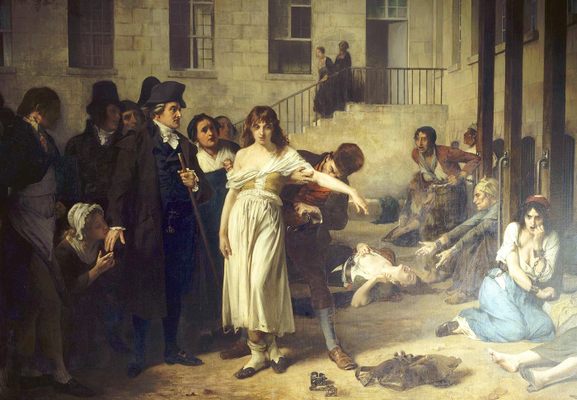About
At first it was the fate of the female beggars but more and more, other women began to be labeled and taken. Prostitutes, crazies, orphans, libertines, protestants, cripples, cretins, Jews, criminals, alcoholics, moribunds, witches, melancolics, the blind, girls born of adultery, lesbians, epileptics, thieves, sorcerers, seniles, idiots, depraved, intriguing minds, erotomaniacs, spoiled girls with suicidal tendencies, bohemians, fatties …
This creative and seemingly endless list showcases a collection of some of the charges, symptoms or assigned behaviors used to ostracize a woman from society. Parisian women of the 1700s could be labeled any one of those things, true or false, branded hysterical, and regardless of her social status could be sent away into the dingy halls of the asylum forever.
Centuries ago, before becoming one of the largest hospital complexes in Europe, La Salpetrière had a less altruistic use as a gunpowder factory. Under Louis XIV, it was turned into an asylum that operated more like a prison, where female outcasts could be shut away from existence. With no promises of recovery or freedom, the unfortunate “patients” usually finished out their natural lives there, “for their own good.”
This era was defined by Michel Foucault as the “Grand Confinement,” when battalions rummaged every night through the darkest streets and dead ends of the capital to arrest the poor, the immoral or the incurable ones. Isolation and repression being considered an effective way to purge debauchery, the prostitutes were gathered at La Force, an imposing prison with a special building just for the ladies. The women were held in "La Petite Force," and their punishment for trying to survive was decided. Some of them would be selected to be deported to Louisiana, Quebec or the Caribbean colonies; others would end up in La Salpetrière.
During the September Massacres of 1792, a frenzied mob invaded the Salpetriere, with the intention of freeing the imprisoned prostitutes. Anger, fear and mob mentality took hold and after the working women were freed, the women that were truly ill were dragged into the streets and brutally murdered, staining the revolution with ugliness.
Starting at Place Camatte Zaydoff, go through Rue des Archers and you’ll see the long, monotone housing constructions that once housed the battalions. Not far from there in Rue des Petites Loges (Quartier Charcot) you’ll come across a series of three one-floored buildings. Established in 1680 to solve La Force’s overpopulation issue, these small houses used to form the so-called “Quartier des Folles,” the district that housed around 600 hysterical women being kept in miniscule cells. Each day, following a highly popular hygiene regimen, the women were chained outdoors to the semicircular benches seated on the floor, allowing them the smallest breath of fresh air.
Tormenting society's delicate sensibilities by their mere presence in the heart of Paris, the disheveled pariahs in their white gowns were anonymous ghosts. These pitifully forgotten remained in their rat hole until their savior, Doctor Pinel, set them free, in a manner of speaking, with his revolutionary ideas of moral therapy and humane mental health care.
Related Tags
Know Before You Go
Metro Saint Marcel
Published
January 16, 2013






















